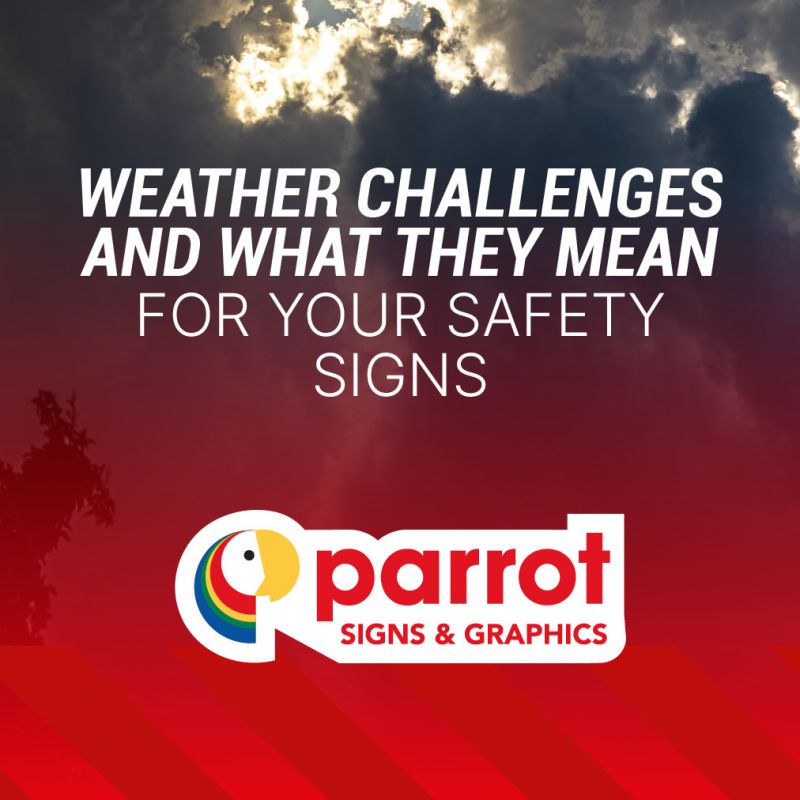Weather Challenges and What They Mean for Your Safety Signs
Fri 4th July 2025Safety signs play a critical role in protecting staff, visitors and the public, especially on outdoor sites such as farms, construction zones and public attractions. But in the UK, where the weather can swing from driving rain to unexpected heatwaves, even the most well-placed signs can suffer damage, fading or reduced visibility if not properly designed for outdoor conditions. Choosing the right materials and planning ahead for year-round performance can make all the difference.
How UK weather affects outdoor signage
Britain’s climate is famously unpredictable, but some patterns are worth planning around. The UK averages 133 days of rainfall per year, with the western regions typically seeing the highest totals. Heavy rainfall can compromise safety signs printed on low-grade materials, causing peeling, warping, or complete detachment from fixings. Meanwhile, wind exposure-especially on open farmland or construction sites-can snap brittle signs or dislodge poorly secured ones.
On the flip side, UV exposure during increasingly hot summers also poses a risk. The Met Office reports that 2022 was the UK’s warmest year on record, with average temperatures reaching 10.03°C, surpassing the previous high set in 2014. Prolonged sun exposure can bleach signage, fade warning symbols, and reduce overall legibility, especially where ink quality or protective lamination is lacking.
Recently, we replaced a sign that had initially been made on 1mm PVC. Heat from the summer sun caused this sign to melt and warp beyond functionality. We recommend for signs that are being deployed in a place exposed to even a small amount of sun that 3mm rigid board is used. This has higher resistance to heat and will extend the sign’s life.
Selecting weather-resistant materials
To weather-proof your safety signs, materials matter. For most UK outdoor settings, consider:
-
Dibond (aluminium composite): Lightweight, rust-proof, and able to withstand both rain and sun. Ideal for exposed areas like gates, fences or walls.
-
Rigid plastic (polypropylene or polycarbonate): A cost-effective choice that resists cracking and UV fading, especially when treated with anti-glare or UV coatings.
-
PVC foam board: Better suited for sheltered outdoor use. It’s light and easy to mount but can degrade in prolonged wet conditions.
-
Reflective finishes: Particularly useful for low-light or foggy conditions, ensuring critical signs remain visible at dawn, dusk or in bad weather.
Mounting methods also affect longevity. Use rust-resistant fixings and consider anti-vandal fittings for high-traffic or remote areas.
Safety signs and seasonal visibility
Changes in the seasons can affect both how visible and how effective safety signs are. In winter, reduced daylight hours and glare from low sun can impair readability. Reflective signs, as mentioned earlier, are especially useful in these conditions. Meanwhile, vegetation growth in spring and summer can obscure signage-something frequently encountered on farms and rural footpaths.
It's also worth noting that temporary signs used for events or construction work should be equally weather-ready. Laminated, reusable options with durable fixings can reduce waste and improve compliance.
Maintenance matters
Even the most robust signs need checking. A simple visual inspection every few months can reveal early signs of wear, such as cracks, fading, or corrosion. Make it part of your site’s health and safety walkabout or monthly risk review.
Where safety signs are essential for legal compliance such as chemical storage warnings or site entrance regulations, any degradation can potentially lead to HSE issues. Regular updates and prompt replacement are key to avoiding fines and keeping people safe.
Read more >> How to Tell When You Need to Replace Your Workplace Safety Signs
Final thoughts on weather-proof safety signs
With the UK’s diverse and often challenging weather conditions, ensuring your safety signs are fit for purpose all year round is more than just good practice; it’s a legal and operational priority. By choosing durable materials, planning for seasonal changes, and staying on top of maintenance, businesses can keep their signs clear, compliant and effective whatever the weather throws at them.
